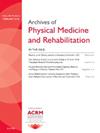Systematic Review of Upper Extremity Outcome Measures Assessed in Randomized Controlled Trials of Poststroke Upper Extremity Rehabilitation in Low-to-Middle-Income and High-Income Countries
IF 3.6
2区 医学
Q1 REHABILITATION
Archives of physical medicine and rehabilitation
Pub Date : 2025-04-01
DOI:10.1016/j.apmr.2024.08.029
引用次数: 0
Abstract
Objective
To systematically review randomized controlled trials (RCTs) of poststroke upper extremity (UE) motor rehabilitation interventions to identify the outcome measures used in studies in low-to-middle-income countries (LMICs) and high-income countries (HICs) and describe the differences in the context of the International Classification of Functioning, Disability and Health.
Data Sources
Five databases “Embase, PubMed, CINAHL, Scopus, and Web of Science” were searched from 1960 to April 1, 2021.
Study Selection
Studies were included if they were (1) RCTs or RCT crossovers in English; (2) with ≥50% participants affected by ischemic/hemorrhagic stroke; (3) participants aged ≥18 years; and (4) used an intervention for the hemiparetic UE as the primary objective of the study.
Data Extraction
Title and abstract screening and full-text studies were reviewed, and data for included studies were extracted by two independent investigators. The study quality was assessed using the Physiotherapy Evidence Database scale. Data analyses were performed using SPSS (V29.0).
Data Synthesis
Of 5408 records, 1276 RCTs were eligible, 298 RCTs were conducted in LMICs and 978 in HICs. A higher percentage of RCTs in LMICs employed body structure and function outcome measures for central nervous system (eg, Fugl-Meyer Assessment) and tone and range of motion (eg, modified Ashworth Scale) as well as activity outcome measures for general activities of daily living (eg, Barthel Index). In HICs, a higher percentage of RCTs used body structure and function outcome measures assessing strength (eg, Motricity Index), activity outcome measures examining motor specific activity (eg, Action Research Arm Test and Wolf Motor Function Test) and dexterity (eg, Box and Block Test), as well as participation outcome measures (eg, Stroke Impact Scale).
Conclusions
There were significant differences in the outcome measures chosen for assessing poststroke UE rehabilitation interventions by researchers in LMICs and HICs. This suggests that there might be potential resource and expertise as well as timing constraints that influences the choice of outcome measures in RCTs between HICs and LMICs and highlights the need for investigating the availability of resources, infrastructure, and expertise and their effect on the feasibility and practicality of employing different outcome measures in different countries.
中低收入国家和高收入国家卒中后上肢康复随机对照试验中评估的上肢康复结果的系统回顾。
目的系统回顾有关卒中后上肢运动康复干预的随机对照试验(RCT),以确定中低收入国家(LMIC)和高收入国家(HIC)的研究中使用的结果测量方法,并描述在国际功能、残疾和健康分类(ICF)背景下的差异:数据来源:检索了从 1960 年至 2021 年 4 月 1 日的五个数据库 "Embase、PubMed、CINAHL、Scopus 和 Web of Science":如果研究是1)英文的 RCT 或 RCT 交叉研究;2)受缺血性/出血性卒中影响的参与者比例≥50%;3)参与者年龄≥18 岁;4)将干预偏瘫 UE 作为研究的主要目标:对标题和摘要筛选以及全文研究进行审查,由两名独立调查人员对纳入研究的数据进行提取。研究质量采用物理治疗证据数据库(PEDro)量表进行评估。数据分析采用 SPSS (V29.0):在 5,408 条记录中,有 1,276 项研究符合条件,其中 298 项研究在低收入和中等收入国家进行,978 项研究在高收入国家进行。在低收入和中等收入国家进行的研究中,采用身体结构和功能结果测量中枢神经系统(如 Fugl Meyer 评估)、肌张力和活动范围(如修正的 Ashworth 量表)以及一般日常生活活动结果测量(如 Barthel 指数)的比例较高。在高危人群中,采用身体结构和功能结果测量评估力量(如运动指数)、活动结果测量检查特定运动活动(如行动研究臂测试、沃尔夫运动功能测试)和灵巧性(如箱形和块形测试)以及参与结果测量(如卒中影响量表)的 RCT 所占比例较高:结论:低收入、中等收入国家和高收入国家的研究人员在评估卒中后自立康复干预措施时所选择的结果测量指标存在明显差异。这表明可能存在潜在的资源和专业知识以及时间限制,影响着高收入国家和低收入国家之间在 RCT 中对结果测量方法的选择,并强调有必要调查资源、基础设施和专业知识的可用性及其对不同国家采用不同结果测量方法的可行性和实用性的影响。
本文章由计算机程序翻译,如有差异,请以英文原文为准。
求助全文
约1分钟内获得全文
求助全文
来源期刊
CiteScore
6.20
自引率
4.70%
发文量
495
审稿时长
38 days
期刊介绍:
The Archives of Physical Medicine and Rehabilitation publishes original, peer-reviewed research and clinical reports on important trends and developments in physical medicine and rehabilitation and related fields. This international journal brings researchers and clinicians authoritative information on the therapeutic utilization of physical, behavioral and pharmaceutical agents in providing comprehensive care for individuals with chronic illness and disabilities.
Archives began publication in 1920, publishes monthly, and is the official journal of the American Congress of Rehabilitation Medicine. Its papers are cited more often than any other rehabilitation journal.

 求助内容:
求助内容: 应助结果提醒方式:
应助结果提醒方式:


